Organizational Behavior Audit Plan for Local Company (MBALN-701)
VerifiedAdded on 2023/04/19
|16
|4064
|497
Report
AI Summary
This report presents a comprehensive plan for conducting an Organizational Behavior (OB) audit, designed for a local company. It begins by explaining the rationale behind conducting an OB audit, emphasizing its importance in understanding employee behavior, improving the working environment, and enhancing overall organizational performance. The plan outlines the key areas that should be evaluated, including the organization's structure, group dynamics, and individual employee behaviors. Within each area, the report identifies specific factors that require assessment, such as individual abilities, attitudes, perceptions, and the influence of race and culture. The report also details the steps involved in conducting the audit, from establishing the main problem and gathering information to data analysis and conclusion. The executive summary highlights the mid-term examination aspect of the report, emphasizing the practical application of OB principles to real-world organizational challenges. The report underscores the significance of OB audits in identifying areas for improvement, fostering a positive work environment, and ensuring the long-term success of the organization. The plan is designed to provide a clear roadmap for the company to effectively assess and improve its organizational behavior.
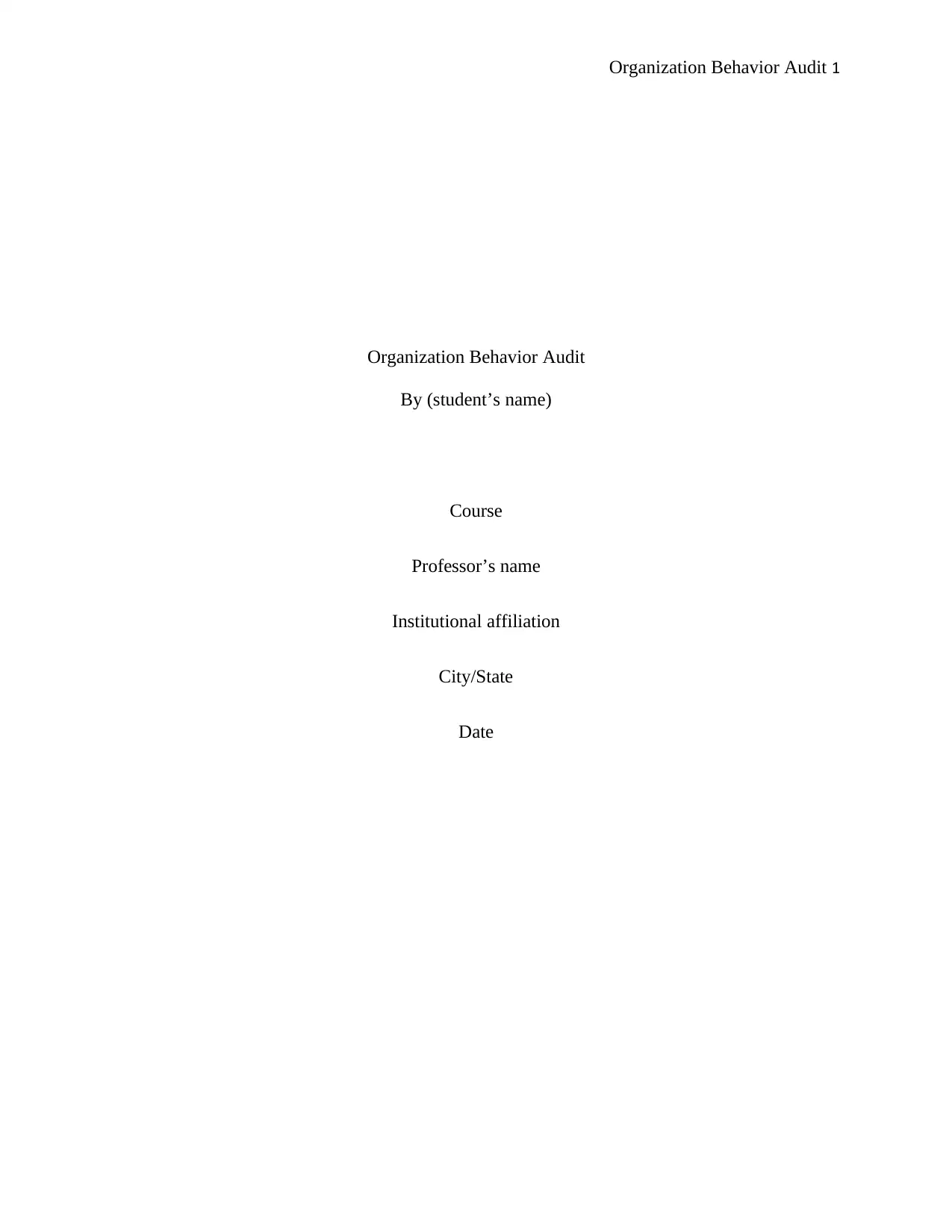
Organization Behavior Audit 1
Organization Behavior Audit
By (student’s name)
Course
Professor’s name
Institutional affiliation
City/State
Date
Organization Behavior Audit
By (student’s name)
Course
Professor’s name
Institutional affiliation
City/State
Date
Paraphrase This Document
Need a fresh take? Get an instant paraphrase of this document with our AI Paraphraser
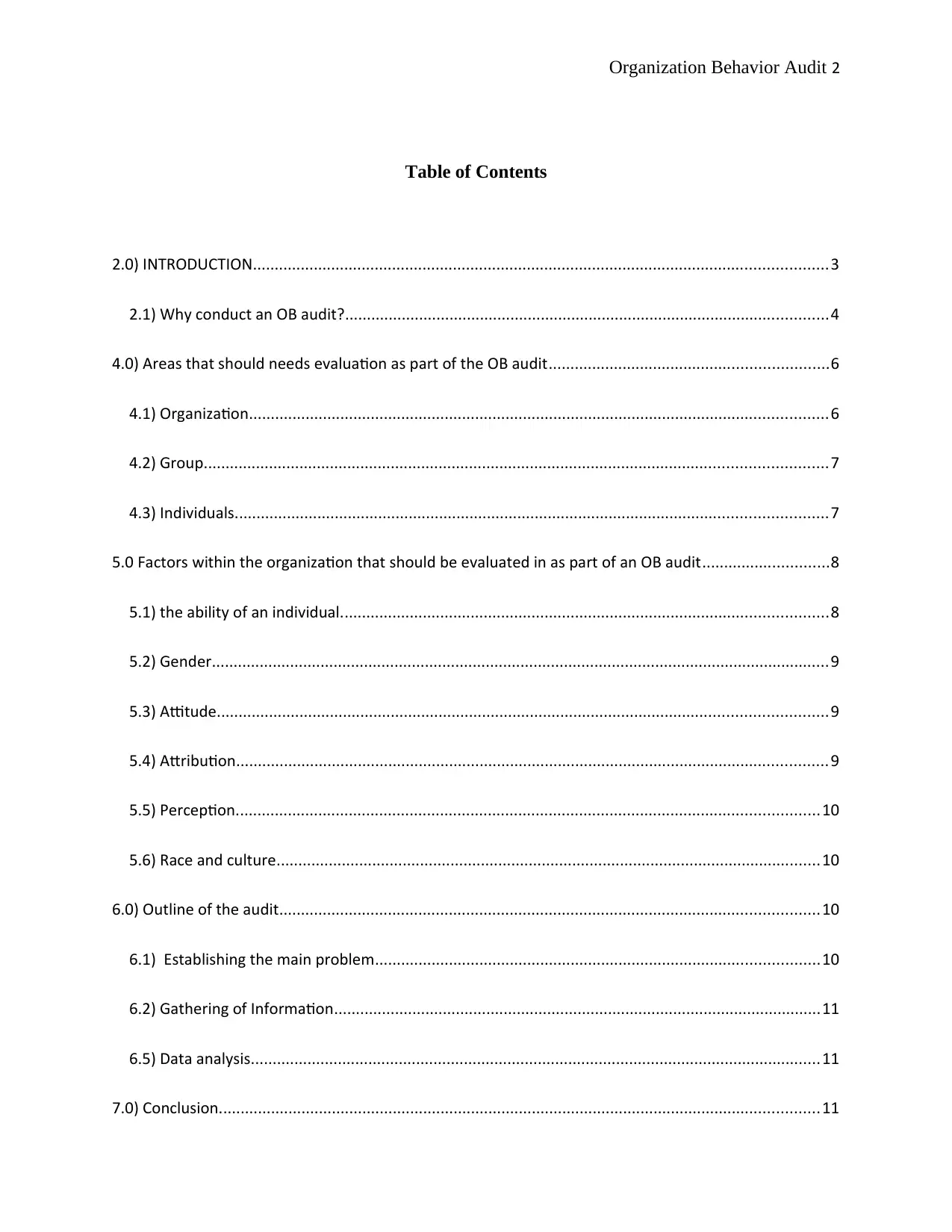
Organization Behavior Audit 2
Table of Contents
2.0) INTRODUCTION....................................................................................................................................3
2.1) Why conduct an OB audit?...............................................................................................................4
4.0) Areas that should needs evaluation as part of the OB audit................................................................6
4.1) Organization.....................................................................................................................................6
4.2) Group...............................................................................................................................................7
4.3) Individuals........................................................................................................................................7
5.0 Factors within the organization that should be evaluated in as part of an OB audit.............................8
5.1) the ability of an individual................................................................................................................8
5.2) Gender..............................................................................................................................................9
5.3) Attitude............................................................................................................................................9
5.4) Attribution........................................................................................................................................9
5.5) Perception......................................................................................................................................10
5.6) Race and culture.............................................................................................................................10
6.0) Outline of the audit............................................................................................................................10
6.1) Establishing the main problem......................................................................................................10
6.2) Gathering of Information................................................................................................................11
6.5) Data analysis...................................................................................................................................11
7.0) Conclusion..........................................................................................................................................11
Table of Contents
2.0) INTRODUCTION....................................................................................................................................3
2.1) Why conduct an OB audit?...............................................................................................................4
4.0) Areas that should needs evaluation as part of the OB audit................................................................6
4.1) Organization.....................................................................................................................................6
4.2) Group...............................................................................................................................................7
4.3) Individuals........................................................................................................................................7
5.0 Factors within the organization that should be evaluated in as part of an OB audit.............................8
5.1) the ability of an individual................................................................................................................8
5.2) Gender..............................................................................................................................................9
5.3) Attitude............................................................................................................................................9
5.4) Attribution........................................................................................................................................9
5.5) Perception......................................................................................................................................10
5.6) Race and culture.............................................................................................................................10
6.0) Outline of the audit............................................................................................................................10
6.1) Establishing the main problem......................................................................................................10
6.2) Gathering of Information................................................................................................................11
6.5) Data analysis...................................................................................................................................11
7.0) Conclusion..........................................................................................................................................11
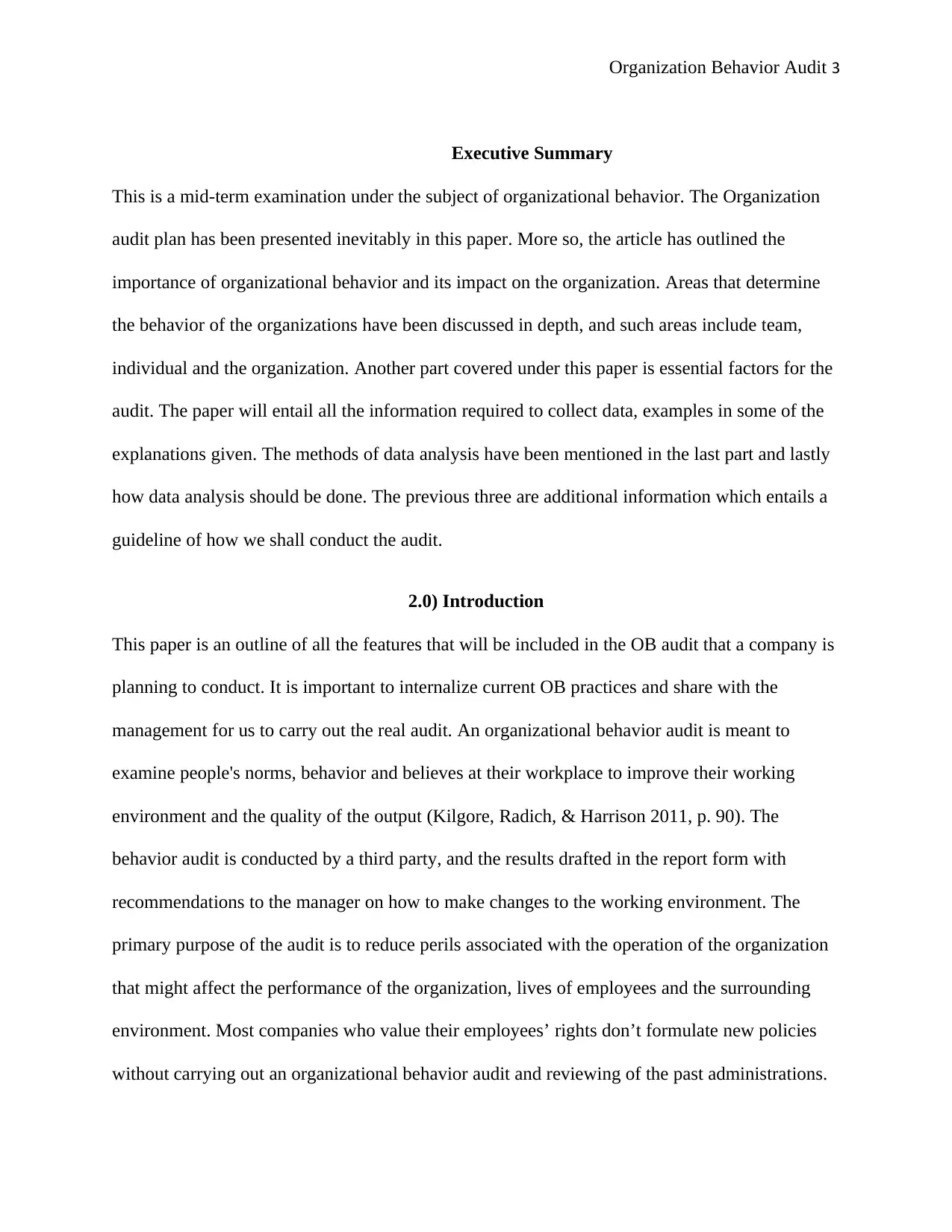
Organization Behavior Audit 3
Executive Summary
This is a mid-term examination under the subject of organizational behavior. The Organization
audit plan has been presented inevitably in this paper. More so, the article has outlined the
importance of organizational behavior and its impact on the organization. Areas that determine
the behavior of the organizations have been discussed in depth, and such areas include team,
individual and the organization. Another part covered under this paper is essential factors for the
audit. The paper will entail all the information required to collect data, examples in some of the
explanations given. The methods of data analysis have been mentioned in the last part and lastly
how data analysis should be done. The previous three are additional information which entails a
guideline of how we shall conduct the audit.
2.0) Introduction
This paper is an outline of all the features that will be included in the OB audit that a company is
planning to conduct. It is important to internalize current OB practices and share with the
management for us to carry out the real audit. An organizational behavior audit is meant to
examine people's norms, behavior and believes at their workplace to improve their working
environment and the quality of the output (Kilgore, Radich, & Harrison 2011, p. 90). The
behavior audit is conducted by a third party, and the results drafted in the report form with
recommendations to the manager on how to make changes to the working environment. The
primary purpose of the audit is to reduce perils associated with the operation of the organization
that might affect the performance of the organization, lives of employees and the surrounding
environment. Most companies who value their employees’ rights don’t formulate new policies
without carrying out an organizational behavior audit and reviewing of the past administrations.
Executive Summary
This is a mid-term examination under the subject of organizational behavior. The Organization
audit plan has been presented inevitably in this paper. More so, the article has outlined the
importance of organizational behavior and its impact on the organization. Areas that determine
the behavior of the organizations have been discussed in depth, and such areas include team,
individual and the organization. Another part covered under this paper is essential factors for the
audit. The paper will entail all the information required to collect data, examples in some of the
explanations given. The methods of data analysis have been mentioned in the last part and lastly
how data analysis should be done. The previous three are additional information which entails a
guideline of how we shall conduct the audit.
2.0) Introduction
This paper is an outline of all the features that will be included in the OB audit that a company is
planning to conduct. It is important to internalize current OB practices and share with the
management for us to carry out the real audit. An organizational behavior audit is meant to
examine people's norms, behavior and believes at their workplace to improve their working
environment and the quality of the output (Kilgore, Radich, & Harrison 2011, p. 90). The
behavior audit is conducted by a third party, and the results drafted in the report form with
recommendations to the manager on how to make changes to the working environment. The
primary purpose of the audit is to reduce perils associated with the operation of the organization
that might affect the performance of the organization, lives of employees and the surrounding
environment. Most companies who value their employees’ rights don’t formulate new policies
without carrying out an organizational behavior audit and reviewing of the past administrations.
⊘ This is a preview!⊘
Do you want full access?
Subscribe today to unlock all pages.

Trusted by 1+ million students worldwide
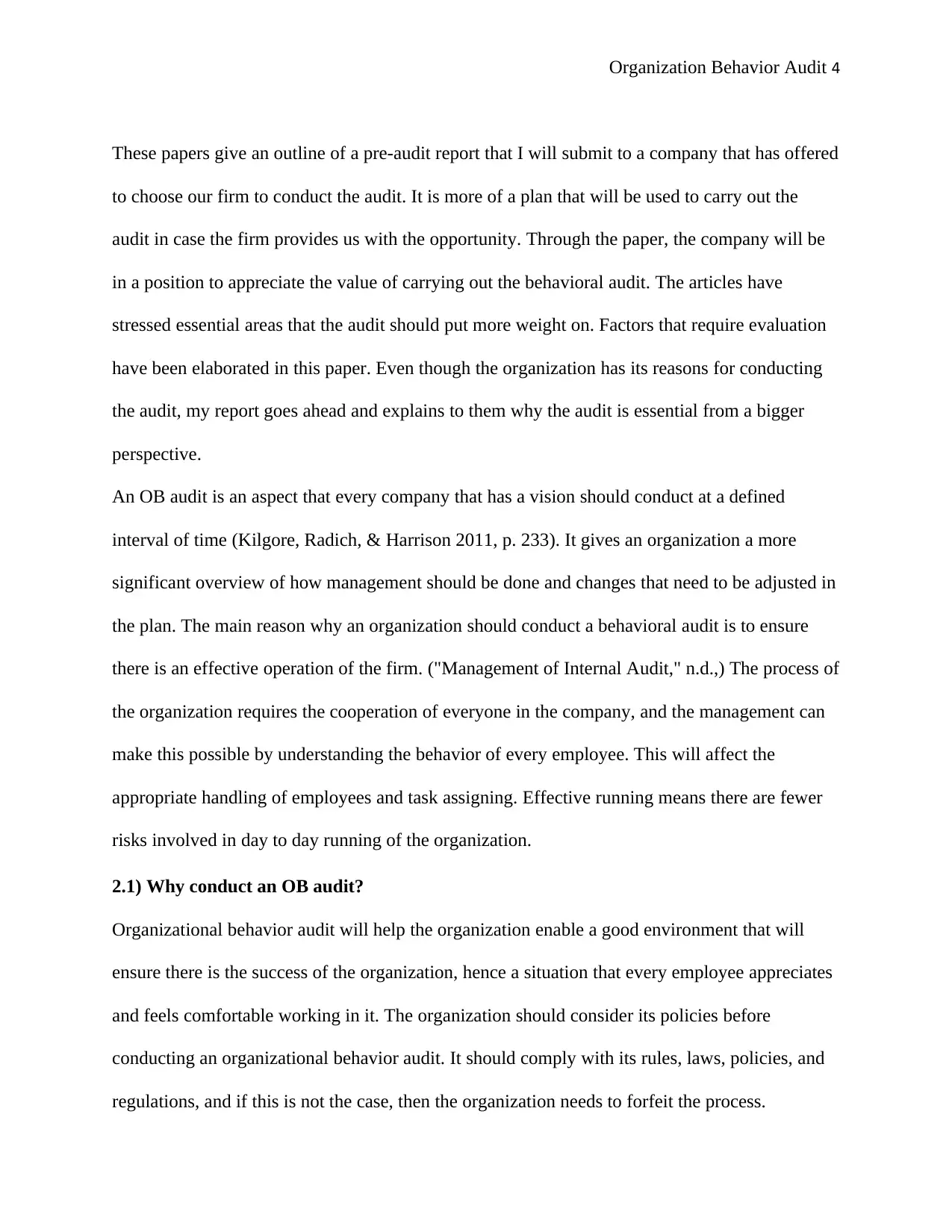
Organization Behavior Audit 4
These papers give an outline of a pre-audit report that I will submit to a company that has offered
to choose our firm to conduct the audit. It is more of a plan that will be used to carry out the
audit in case the firm provides us with the opportunity. Through the paper, the company will be
in a position to appreciate the value of carrying out the behavioral audit. The articles have
stressed essential areas that the audit should put more weight on. Factors that require evaluation
have been elaborated in this paper. Even though the organization has its reasons for conducting
the audit, my report goes ahead and explains to them why the audit is essential from a bigger
perspective.
An OB audit is an aspect that every company that has a vision should conduct at a defined
interval of time (Kilgore, Radich, & Harrison 2011, p. 233). It gives an organization a more
significant overview of how management should be done and changes that need to be adjusted in
the plan. The main reason why an organization should conduct a behavioral audit is to ensure
there is an effective operation of the firm. ("Management of Internal Audit," n.d.,) The process of
the organization requires the cooperation of everyone in the company, and the management can
make this possible by understanding the behavior of every employee. This will affect the
appropriate handling of employees and task assigning. Effective running means there are fewer
risks involved in day to day running of the organization.
2.1) Why conduct an OB audit?
Organizational behavior audit will help the organization enable a good environment that will
ensure there is the success of the organization, hence a situation that every employee appreciates
and feels comfortable working in it. The organization should consider its policies before
conducting an organizational behavior audit. It should comply with its rules, laws, policies, and
regulations, and if this is not the case, then the organization needs to forfeit the process.
These papers give an outline of a pre-audit report that I will submit to a company that has offered
to choose our firm to conduct the audit. It is more of a plan that will be used to carry out the
audit in case the firm provides us with the opportunity. Through the paper, the company will be
in a position to appreciate the value of carrying out the behavioral audit. The articles have
stressed essential areas that the audit should put more weight on. Factors that require evaluation
have been elaborated in this paper. Even though the organization has its reasons for conducting
the audit, my report goes ahead and explains to them why the audit is essential from a bigger
perspective.
An OB audit is an aspect that every company that has a vision should conduct at a defined
interval of time (Kilgore, Radich, & Harrison 2011, p. 233). It gives an organization a more
significant overview of how management should be done and changes that need to be adjusted in
the plan. The main reason why an organization should conduct a behavioral audit is to ensure
there is an effective operation of the firm. ("Management of Internal Audit," n.d.,) The process of
the organization requires the cooperation of everyone in the company, and the management can
make this possible by understanding the behavior of every employee. This will affect the
appropriate handling of employees and task assigning. Effective running means there are fewer
risks involved in day to day running of the organization.
2.1) Why conduct an OB audit?
Organizational behavior audit will help the organization enable a good environment that will
ensure there is the success of the organization, hence a situation that every employee appreciates
and feels comfortable working in it. The organization should consider its policies before
conducting an organizational behavior audit. It should comply with its rules, laws, policies, and
regulations, and if this is not the case, then the organization needs to forfeit the process.
Paraphrase This Document
Need a fresh take? Get an instant paraphrase of this document with our AI Paraphraser
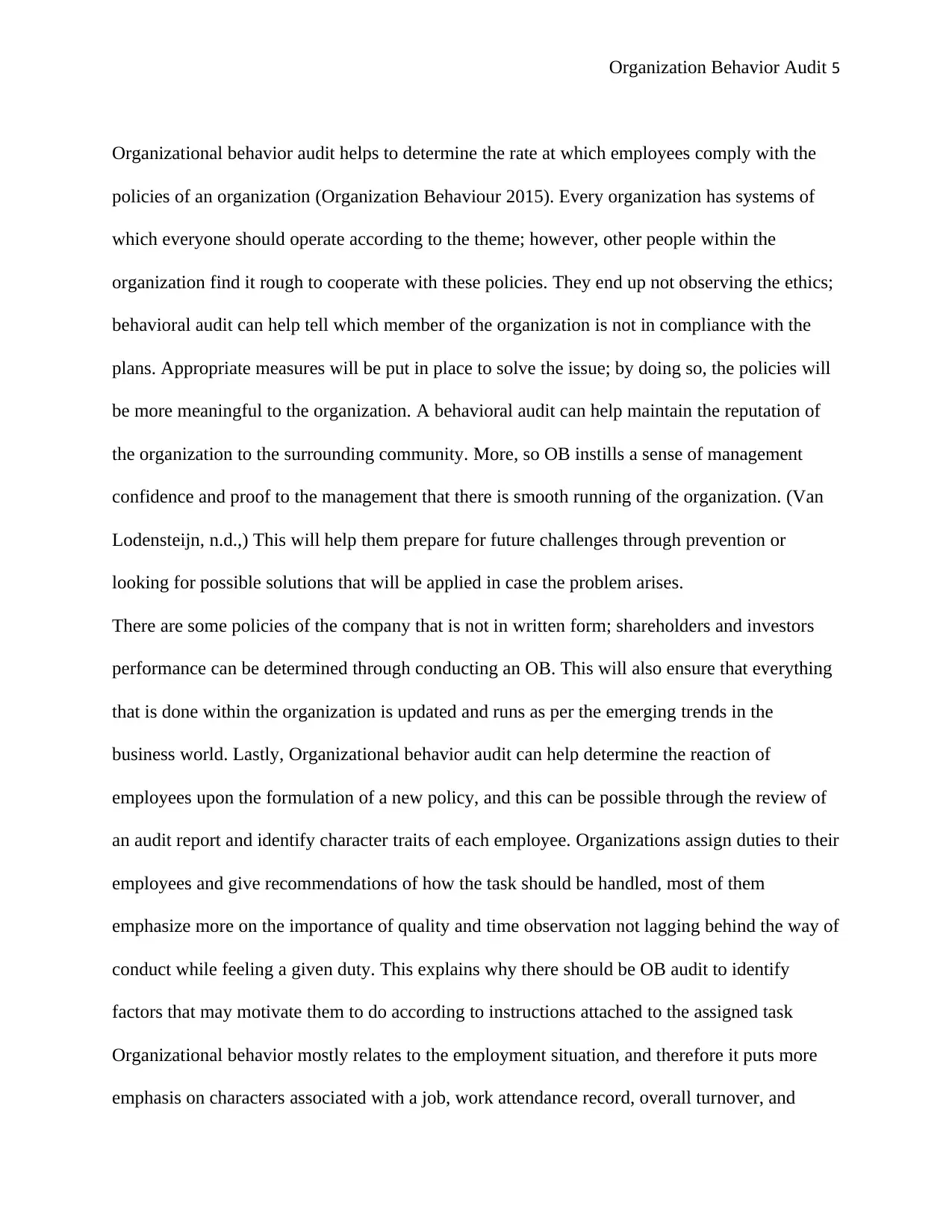
Organization Behavior Audit 5
Organizational behavior audit helps to determine the rate at which employees comply with the
policies of an organization (Organization Behaviour 2015). Every organization has systems of
which everyone should operate according to the theme; however, other people within the
organization find it rough to cooperate with these policies. They end up not observing the ethics;
behavioral audit can help tell which member of the organization is not in compliance with the
plans. Appropriate measures will be put in place to solve the issue; by doing so, the policies will
be more meaningful to the organization. A behavioral audit can help maintain the reputation of
the organization to the surrounding community. More, so OB instills a sense of management
confidence and proof to the management that there is smooth running of the organization. (Van
Lodensteijn, n.d.,) This will help them prepare for future challenges through prevention or
looking for possible solutions that will be applied in case the problem arises.
There are some policies of the company that is not in written form; shareholders and investors
performance can be determined through conducting an OB. This will also ensure that everything
that is done within the organization is updated and runs as per the emerging trends in the
business world. Lastly, Organizational behavior audit can help determine the reaction of
employees upon the formulation of a new policy, and this can be possible through the review of
an audit report and identify character traits of each employee. Organizations assign duties to their
employees and give recommendations of how the task should be handled, most of them
emphasize more on the importance of quality and time observation not lagging behind the way of
conduct while feeling a given duty. This explains why there should be OB audit to identify
factors that may motivate them to do according to instructions attached to the assigned task
Organizational behavior mostly relates to the employment situation, and therefore it puts more
emphasis on characters associated with a job, work attendance record, overall turnover, and
Organizational behavior audit helps to determine the rate at which employees comply with the
policies of an organization (Organization Behaviour 2015). Every organization has systems of
which everyone should operate according to the theme; however, other people within the
organization find it rough to cooperate with these policies. They end up not observing the ethics;
behavioral audit can help tell which member of the organization is not in compliance with the
plans. Appropriate measures will be put in place to solve the issue; by doing so, the policies will
be more meaningful to the organization. A behavioral audit can help maintain the reputation of
the organization to the surrounding community. More, so OB instills a sense of management
confidence and proof to the management that there is smooth running of the organization. (Van
Lodensteijn, n.d.,) This will help them prepare for future challenges through prevention or
looking for possible solutions that will be applied in case the problem arises.
There are some policies of the company that is not in written form; shareholders and investors
performance can be determined through conducting an OB. This will also ensure that everything
that is done within the organization is updated and runs as per the emerging trends in the
business world. Lastly, Organizational behavior audit can help determine the reaction of
employees upon the formulation of a new policy, and this can be possible through the review of
an audit report and identify character traits of each employee. Organizations assign duties to their
employees and give recommendations of how the task should be handled, most of them
emphasize more on the importance of quality and time observation not lagging behind the way of
conduct while feeling a given duty. This explains why there should be OB audit to identify
factors that may motivate them to do according to instructions attached to the assigned task
Organizational behavior mostly relates to the employment situation, and therefore it puts more
emphasis on characters associated with a job, work attendance record, overall turnover, and
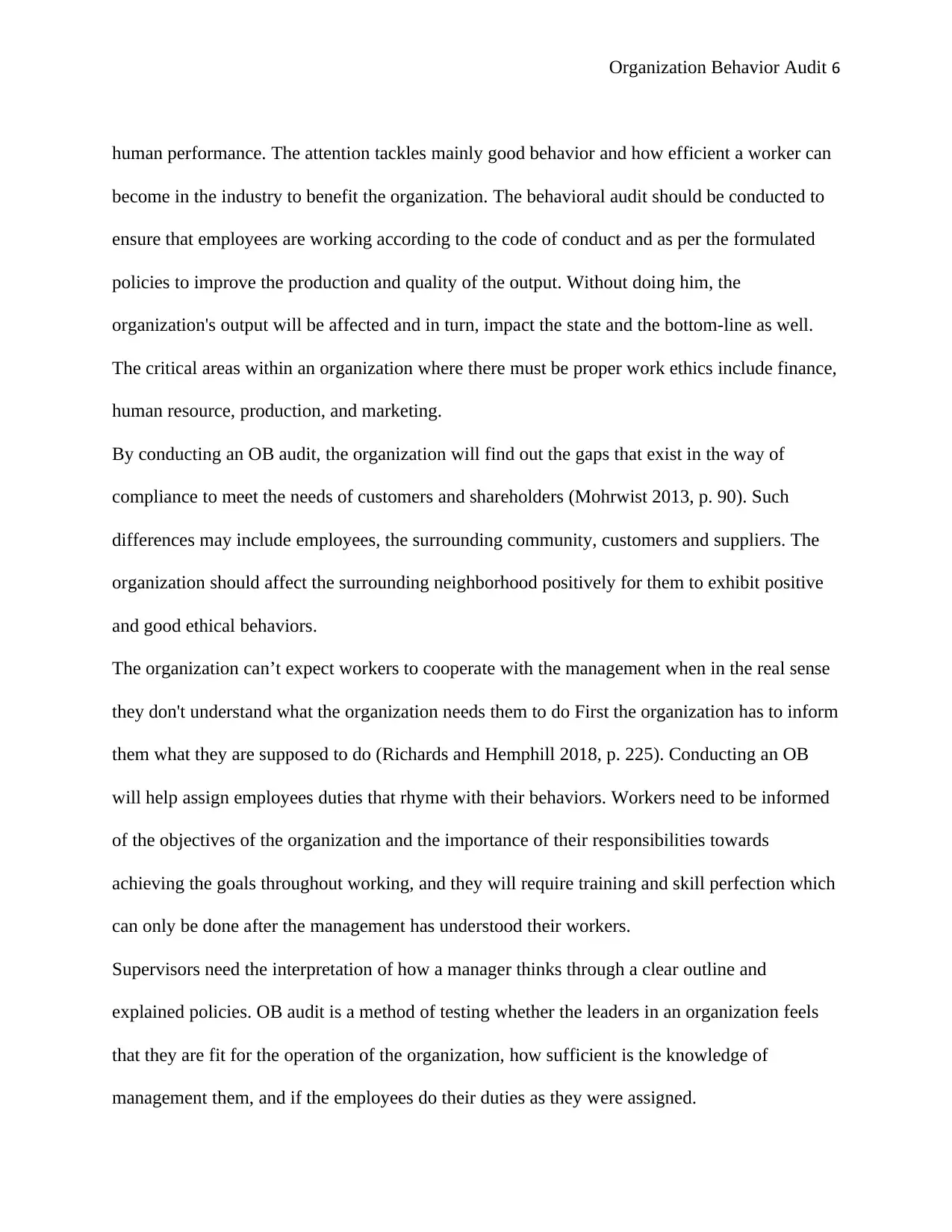
Organization Behavior Audit 6
human performance. The attention tackles mainly good behavior and how efficient a worker can
become in the industry to benefit the organization. The behavioral audit should be conducted to
ensure that employees are working according to the code of conduct and as per the formulated
policies to improve the production and quality of the output. Without doing him, the
organization's output will be affected and in turn, impact the state and the bottom-line as well.
The critical areas within an organization where there must be proper work ethics include finance,
human resource, production, and marketing.
By conducting an OB audit, the organization will find out the gaps that exist in the way of
compliance to meet the needs of customers and shareholders (Mohrwist 2013, p. 90). Such
differences may include employees, the surrounding community, customers and suppliers. The
organization should affect the surrounding neighborhood positively for them to exhibit positive
and good ethical behaviors.
The organization can’t expect workers to cooperate with the management when in the real sense
they don't understand what the organization needs them to do First the organization has to inform
them what they are supposed to do (Richards and Hemphill 2018, p. 225). Conducting an OB
will help assign employees duties that rhyme with their behaviors. Workers need to be informed
of the objectives of the organization and the importance of their responsibilities towards
achieving the goals throughout working, and they will require training and skill perfection which
can only be done after the management has understood their workers.
Supervisors need the interpretation of how a manager thinks through a clear outline and
explained policies. OB audit is a method of testing whether the leaders in an organization feels
that they are fit for the operation of the organization, how sufficient is the knowledge of
management them, and if the employees do their duties as they were assigned.
human performance. The attention tackles mainly good behavior and how efficient a worker can
become in the industry to benefit the organization. The behavioral audit should be conducted to
ensure that employees are working according to the code of conduct and as per the formulated
policies to improve the production and quality of the output. Without doing him, the
organization's output will be affected and in turn, impact the state and the bottom-line as well.
The critical areas within an organization where there must be proper work ethics include finance,
human resource, production, and marketing.
By conducting an OB audit, the organization will find out the gaps that exist in the way of
compliance to meet the needs of customers and shareholders (Mohrwist 2013, p. 90). Such
differences may include employees, the surrounding community, customers and suppliers. The
organization should affect the surrounding neighborhood positively for them to exhibit positive
and good ethical behaviors.
The organization can’t expect workers to cooperate with the management when in the real sense
they don't understand what the organization needs them to do First the organization has to inform
them what they are supposed to do (Richards and Hemphill 2018, p. 225). Conducting an OB
will help assign employees duties that rhyme with their behaviors. Workers need to be informed
of the objectives of the organization and the importance of their responsibilities towards
achieving the goals throughout working, and they will require training and skill perfection which
can only be done after the management has understood their workers.
Supervisors need the interpretation of how a manager thinks through a clear outline and
explained policies. OB audit is a method of testing whether the leaders in an organization feels
that they are fit for the operation of the organization, how sufficient is the knowledge of
management them, and if the employees do their duties as they were assigned.
⊘ This is a preview!⊘
Do you want full access?
Subscribe today to unlock all pages.

Trusted by 1+ million students worldwide
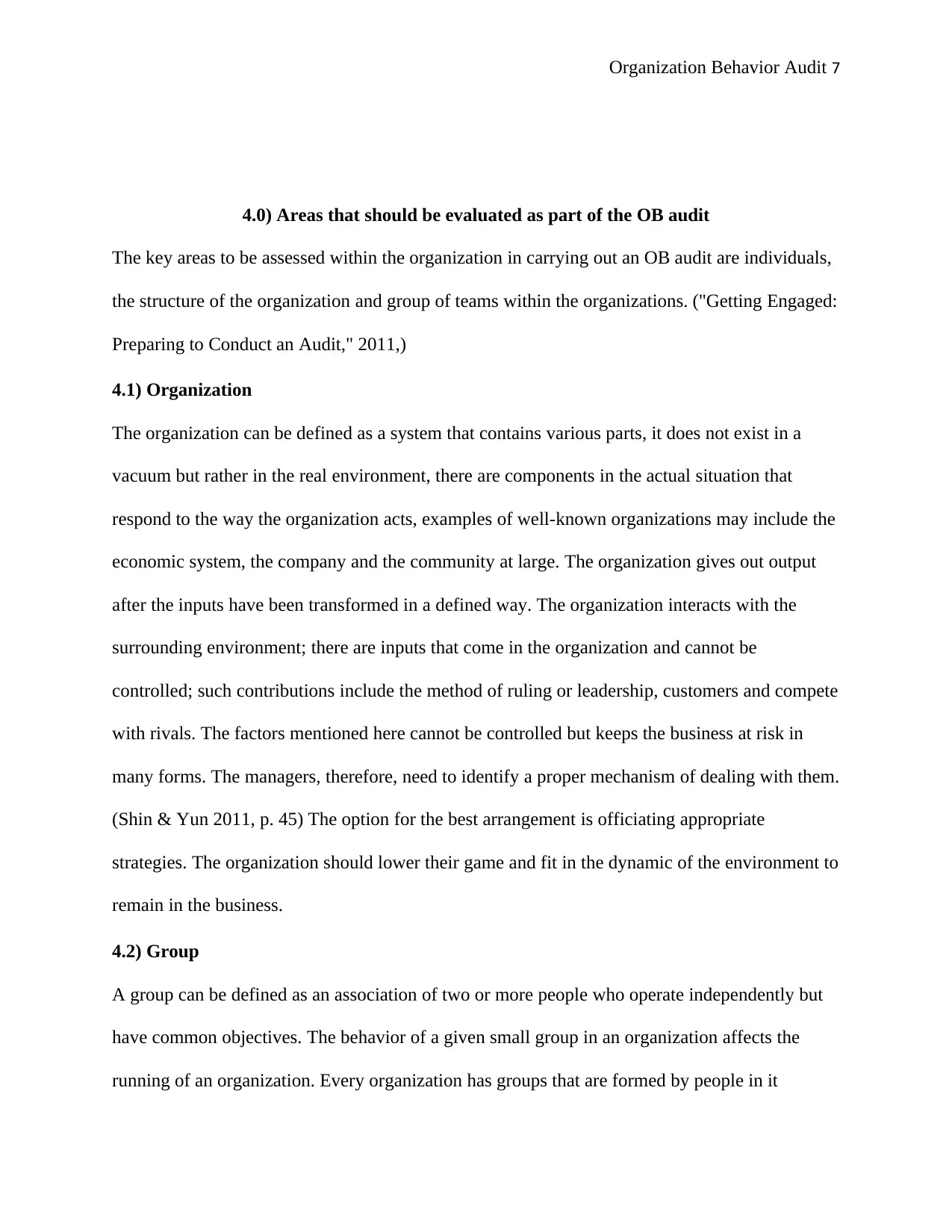
Organization Behavior Audit 7
4.0) Areas that should be evaluated as part of the OB audit
The key areas to be assessed within the organization in carrying out an OB audit are individuals,
the structure of the organization and group of teams within the organizations. ("Getting Engaged:
Preparing to Conduct an Audit," 2011,)
4.1) Organization
The organization can be defined as a system that contains various parts, it does not exist in a
vacuum but rather in the real environment, there are components in the actual situation that
respond to the way the organization acts, examples of well-known organizations may include the
economic system, the company and the community at large. The organization gives out output
after the inputs have been transformed in a defined way. The organization interacts with the
surrounding environment; there are inputs that come in the organization and cannot be
controlled; such contributions include the method of ruling or leadership, customers and compete
with rivals. The factors mentioned here cannot be controlled but keeps the business at risk in
many forms. The managers, therefore, need to identify a proper mechanism of dealing with them.
(Shin & Yun 2011, p. 45) The option for the best arrangement is officiating appropriate
strategies. The organization should lower their game and fit in the dynamic of the environment to
remain in the business.
4.2) Group
A group can be defined as an association of two or more people who operate independently but
have common objectives. The behavior of a given small group in an organization affects the
running of an organization. Every organization has groups that are formed by people in it
4.0) Areas that should be evaluated as part of the OB audit
The key areas to be assessed within the organization in carrying out an OB audit are individuals,
the structure of the organization and group of teams within the organizations. ("Getting Engaged:
Preparing to Conduct an Audit," 2011,)
4.1) Organization
The organization can be defined as a system that contains various parts, it does not exist in a
vacuum but rather in the real environment, there are components in the actual situation that
respond to the way the organization acts, examples of well-known organizations may include the
economic system, the company and the community at large. The organization gives out output
after the inputs have been transformed in a defined way. The organization interacts with the
surrounding environment; there are inputs that come in the organization and cannot be
controlled; such contributions include the method of ruling or leadership, customers and compete
with rivals. The factors mentioned here cannot be controlled but keeps the business at risk in
many forms. The managers, therefore, need to identify a proper mechanism of dealing with them.
(Shin & Yun 2011, p. 45) The option for the best arrangement is officiating appropriate
strategies. The organization should lower their game and fit in the dynamic of the environment to
remain in the business.
4.2) Group
A group can be defined as an association of two or more people who operate independently but
have common objectives. The behavior of a given small group in an organization affects the
running of an organization. Every organization has groups that are formed by people in it
Paraphrase This Document
Need a fresh take? Get an instant paraphrase of this document with our AI Paraphraser
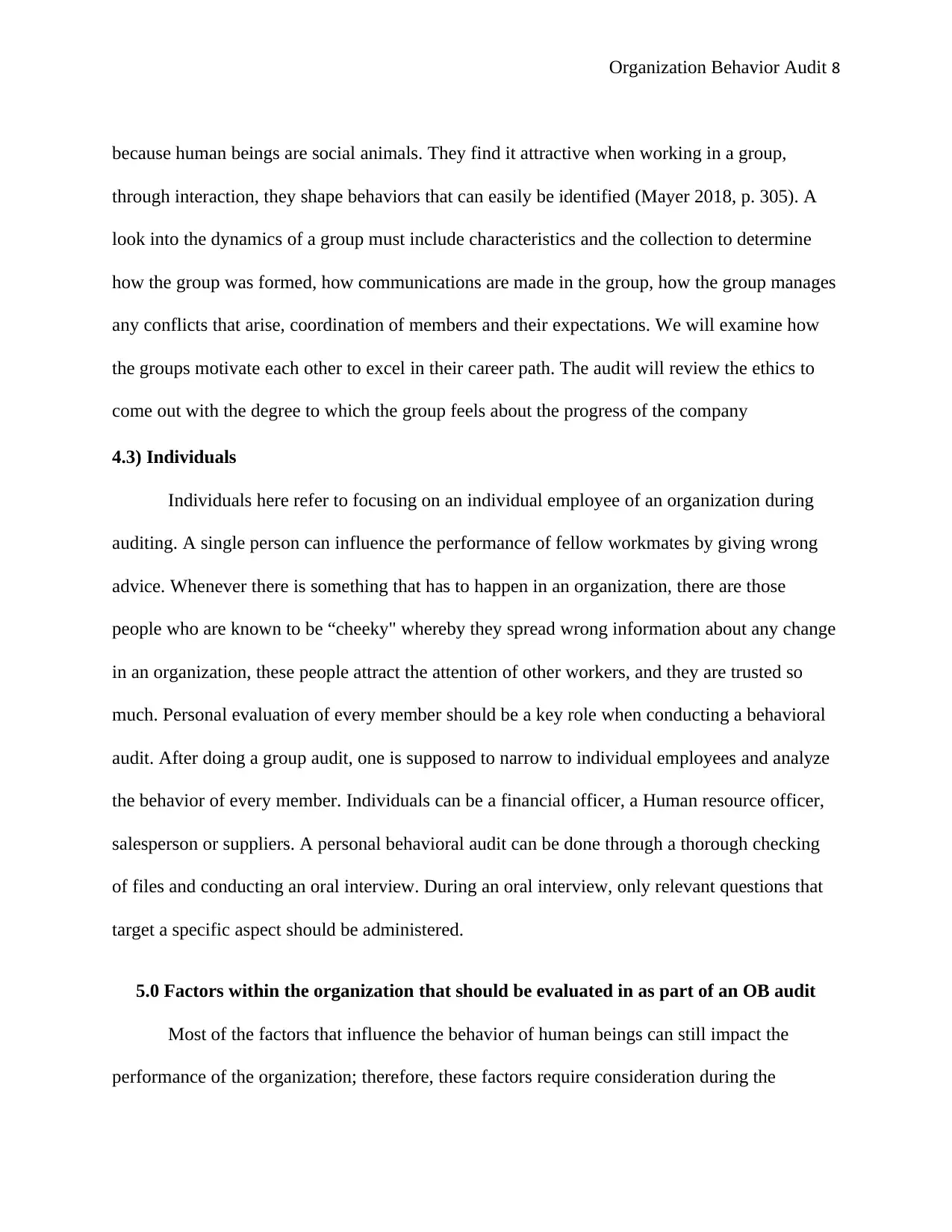
Organization Behavior Audit 8
because human beings are social animals. They find it attractive when working in a group,
through interaction, they shape behaviors that can easily be identified (Mayer 2018, p. 305). A
look into the dynamics of a group must include characteristics and the collection to determine
how the group was formed, how communications are made in the group, how the group manages
any conflicts that arise, coordination of members and their expectations. We will examine how
the groups motivate each other to excel in their career path. The audit will review the ethics to
come out with the degree to which the group feels about the progress of the company
4.3) Individuals
Individuals here refer to focusing on an individual employee of an organization during
auditing. A single person can influence the performance of fellow workmates by giving wrong
advice. Whenever there is something that has to happen in an organization, there are those
people who are known to be “cheeky" whereby they spread wrong information about any change
in an organization, these people attract the attention of other workers, and they are trusted so
much. Personal evaluation of every member should be a key role when conducting a behavioral
audit. After doing a group audit, one is supposed to narrow to individual employees and analyze
the behavior of every member. Individuals can be a financial officer, a Human resource officer,
salesperson or suppliers. A personal behavioral audit can be done through a thorough checking
of files and conducting an oral interview. During an oral interview, only relevant questions that
target a specific aspect should be administered.
5.0 Factors within the organization that should be evaluated in as part of an OB audit
Most of the factors that influence the behavior of human beings can still impact the
performance of the organization; therefore, these factors require consideration during the
because human beings are social animals. They find it attractive when working in a group,
through interaction, they shape behaviors that can easily be identified (Mayer 2018, p. 305). A
look into the dynamics of a group must include characteristics and the collection to determine
how the group was formed, how communications are made in the group, how the group manages
any conflicts that arise, coordination of members and their expectations. We will examine how
the groups motivate each other to excel in their career path. The audit will review the ethics to
come out with the degree to which the group feels about the progress of the company
4.3) Individuals
Individuals here refer to focusing on an individual employee of an organization during
auditing. A single person can influence the performance of fellow workmates by giving wrong
advice. Whenever there is something that has to happen in an organization, there are those
people who are known to be “cheeky" whereby they spread wrong information about any change
in an organization, these people attract the attention of other workers, and they are trusted so
much. Personal evaluation of every member should be a key role when conducting a behavioral
audit. After doing a group audit, one is supposed to narrow to individual employees and analyze
the behavior of every member. Individuals can be a financial officer, a Human resource officer,
salesperson or suppliers. A personal behavioral audit can be done through a thorough checking
of files and conducting an oral interview. During an oral interview, only relevant questions that
target a specific aspect should be administered.
5.0 Factors within the organization that should be evaluated in as part of an OB audit
Most of the factors that influence the behavior of human beings can still impact the
performance of the organization; therefore, these factors require consideration during the
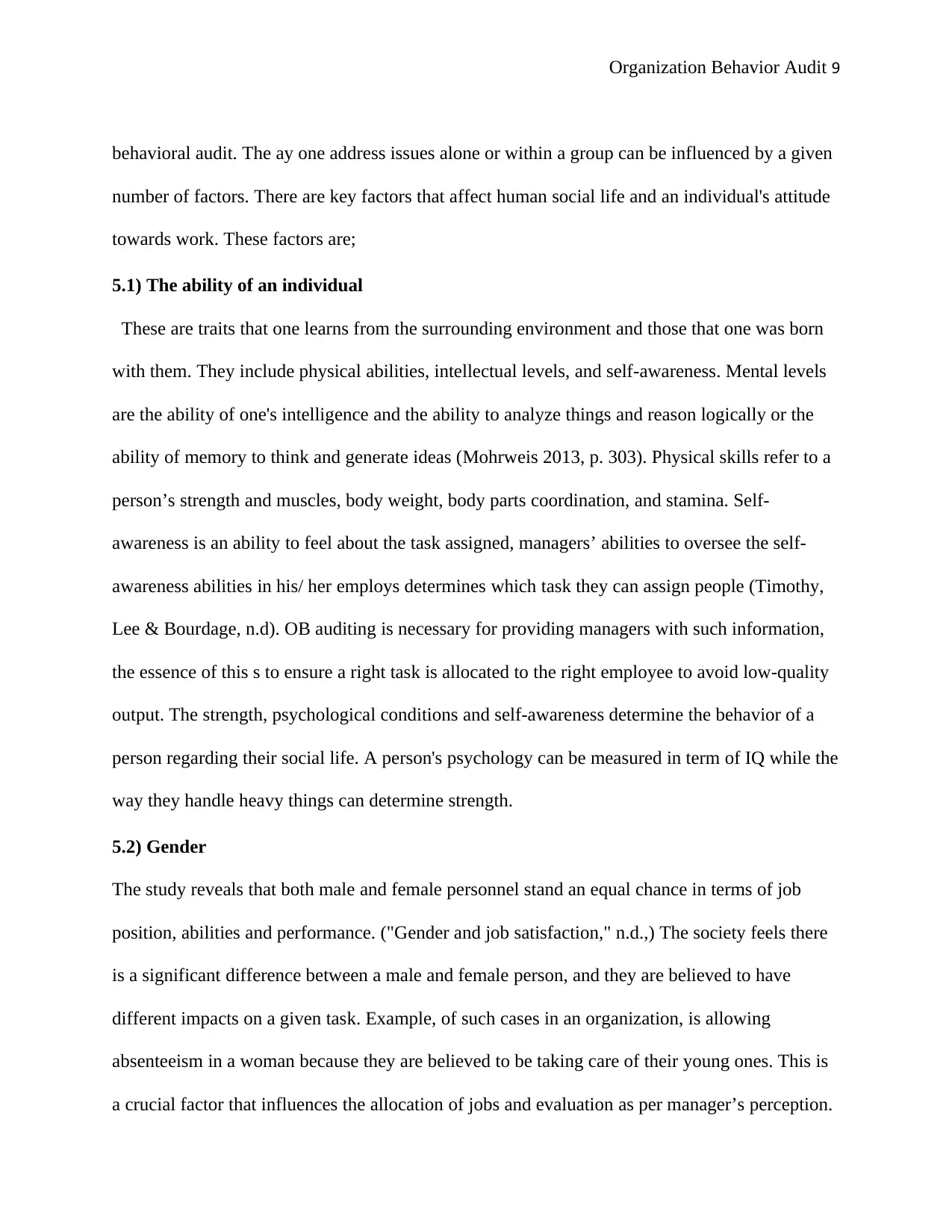
Organization Behavior Audit 9
behavioral audit. The ay one address issues alone or within a group can be influenced by a given
number of factors. There are key factors that affect human social life and an individual's attitude
towards work. These factors are;
5.1) The ability of an individual
These are traits that one learns from the surrounding environment and those that one was born
with them. They include physical abilities, intellectual levels, and self-awareness. Mental levels
are the ability of one's intelligence and the ability to analyze things and reason logically or the
ability of memory to think and generate ideas (Mohrweis 2013, p. 303). Physical skills refer to a
person’s strength and muscles, body weight, body parts coordination, and stamina. Self-
awareness is an ability to feel about the task assigned, managers’ abilities to oversee the self-
awareness abilities in his/ her employs determines which task they can assign people (Timothy,
Lee & Bourdage, n.d). OB auditing is necessary for providing managers with such information,
the essence of this s to ensure a right task is allocated to the right employee to avoid low-quality
output. The strength, psychological conditions and self-awareness determine the behavior of a
person regarding their social life. A person's psychology can be measured in term of IQ while the
way they handle heavy things can determine strength.
5.2) Gender
The study reveals that both male and female personnel stand an equal chance in terms of job
position, abilities and performance. ("Gender and job satisfaction," n.d.,) The society feels there
is a significant difference between a male and female person, and they are believed to have
different impacts on a given task. Example, of such cases in an organization, is allowing
absenteeism in a woman because they are believed to be taking care of their young ones. This is
a crucial factor that influences the allocation of jobs and evaluation as per manager’s perception.
behavioral audit. The ay one address issues alone or within a group can be influenced by a given
number of factors. There are key factors that affect human social life and an individual's attitude
towards work. These factors are;
5.1) The ability of an individual
These are traits that one learns from the surrounding environment and those that one was born
with them. They include physical abilities, intellectual levels, and self-awareness. Mental levels
are the ability of one's intelligence and the ability to analyze things and reason logically or the
ability of memory to think and generate ideas (Mohrweis 2013, p. 303). Physical skills refer to a
person’s strength and muscles, body weight, body parts coordination, and stamina. Self-
awareness is an ability to feel about the task assigned, managers’ abilities to oversee the self-
awareness abilities in his/ her employs determines which task they can assign people (Timothy,
Lee & Bourdage, n.d). OB auditing is necessary for providing managers with such information,
the essence of this s to ensure a right task is allocated to the right employee to avoid low-quality
output. The strength, psychological conditions and self-awareness determine the behavior of a
person regarding their social life. A person's psychology can be measured in term of IQ while the
way they handle heavy things can determine strength.
5.2) Gender
The study reveals that both male and female personnel stand an equal chance in terms of job
position, abilities and performance. ("Gender and job satisfaction," n.d.,) The society feels there
is a significant difference between a male and female person, and they are believed to have
different impacts on a given task. Example, of such cases in an organization, is allowing
absenteeism in a woman because they are believed to be taking care of their young ones. This is
a crucial factor that influences the allocation of jobs and evaluation as per manager’s perception.
⊘ This is a preview!⊘
Do you want full access?
Subscribe today to unlock all pages.

Trusted by 1+ million students worldwide
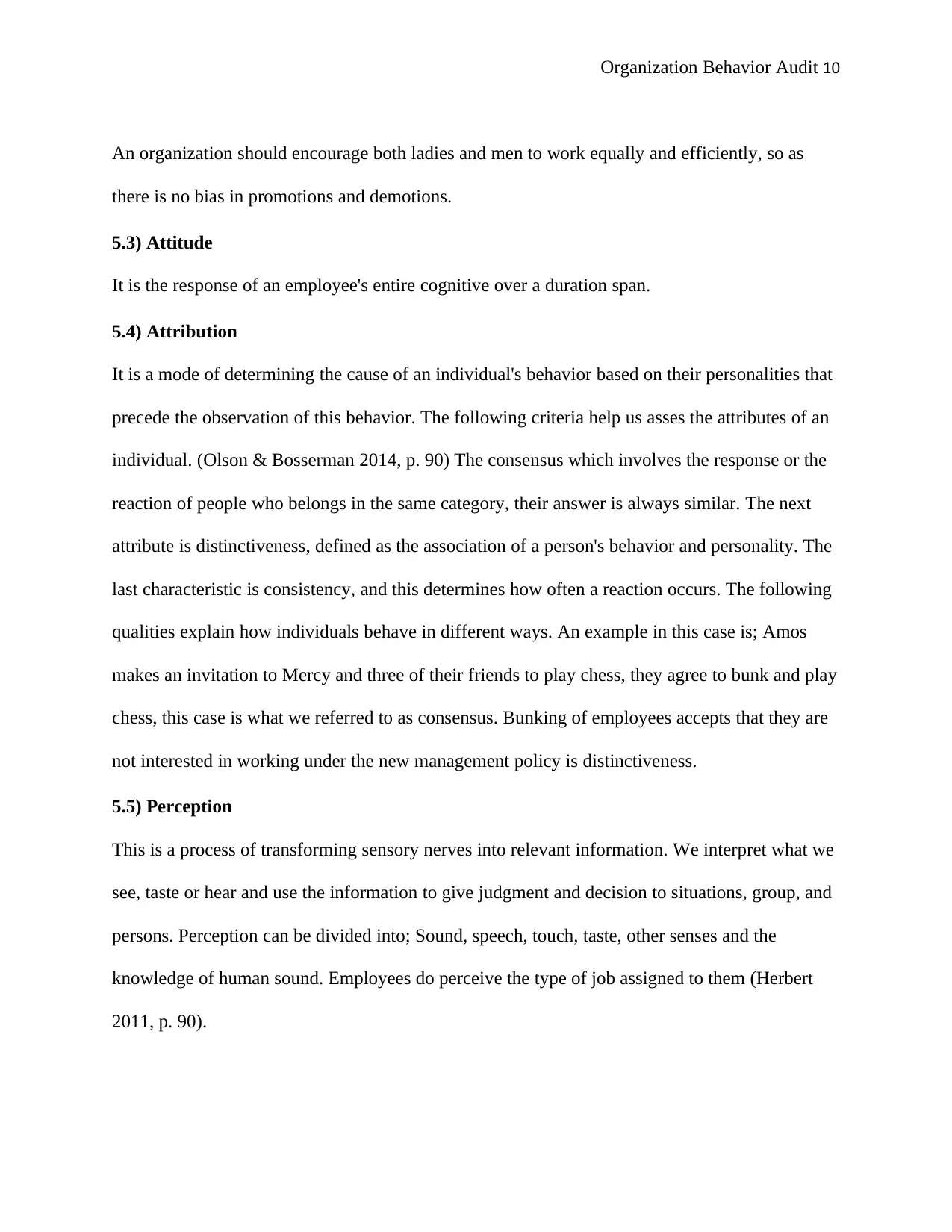
Organization Behavior Audit 10
An organization should encourage both ladies and men to work equally and efficiently, so as
there is no bias in promotions and demotions.
5.3) Attitude
It is the response of an employee's entire cognitive over a duration span.
5.4) Attribution
It is a mode of determining the cause of an individual's behavior based on their personalities that
precede the observation of this behavior. The following criteria help us asses the attributes of an
individual. (Olson & Bosserman 2014, p. 90) The consensus which involves the response or the
reaction of people who belongs in the same category, their answer is always similar. The next
attribute is distinctiveness, defined as the association of a person's behavior and personality. The
last characteristic is consistency, and this determines how often a reaction occurs. The following
qualities explain how individuals behave in different ways. An example in this case is; Amos
makes an invitation to Mercy and three of their friends to play chess, they agree to bunk and play
chess, this case is what we referred to as consensus. Bunking of employees accepts that they are
not interested in working under the new management policy is distinctiveness.
5.5) Perception
This is a process of transforming sensory nerves into relevant information. We interpret what we
see, taste or hear and use the information to give judgment and decision to situations, group, and
persons. Perception can be divided into; Sound, speech, touch, taste, other senses and the
knowledge of human sound. Employees do perceive the type of job assigned to them (Herbert
2011, p. 90).
An organization should encourage both ladies and men to work equally and efficiently, so as
there is no bias in promotions and demotions.
5.3) Attitude
It is the response of an employee's entire cognitive over a duration span.
5.4) Attribution
It is a mode of determining the cause of an individual's behavior based on their personalities that
precede the observation of this behavior. The following criteria help us asses the attributes of an
individual. (Olson & Bosserman 2014, p. 90) The consensus which involves the response or the
reaction of people who belongs in the same category, their answer is always similar. The next
attribute is distinctiveness, defined as the association of a person's behavior and personality. The
last characteristic is consistency, and this determines how often a reaction occurs. The following
qualities explain how individuals behave in different ways. An example in this case is; Amos
makes an invitation to Mercy and three of their friends to play chess, they agree to bunk and play
chess, this case is what we referred to as consensus. Bunking of employees accepts that they are
not interested in working under the new management policy is distinctiveness.
5.5) Perception
This is a process of transforming sensory nerves into relevant information. We interpret what we
see, taste or hear and use the information to give judgment and decision to situations, group, and
persons. Perception can be divided into; Sound, speech, touch, taste, other senses and the
knowledge of human sound. Employees do perceive the type of job assigned to them (Herbert
2011, p. 90).
Paraphrase This Document
Need a fresh take? Get an instant paraphrase of this document with our AI Paraphraser
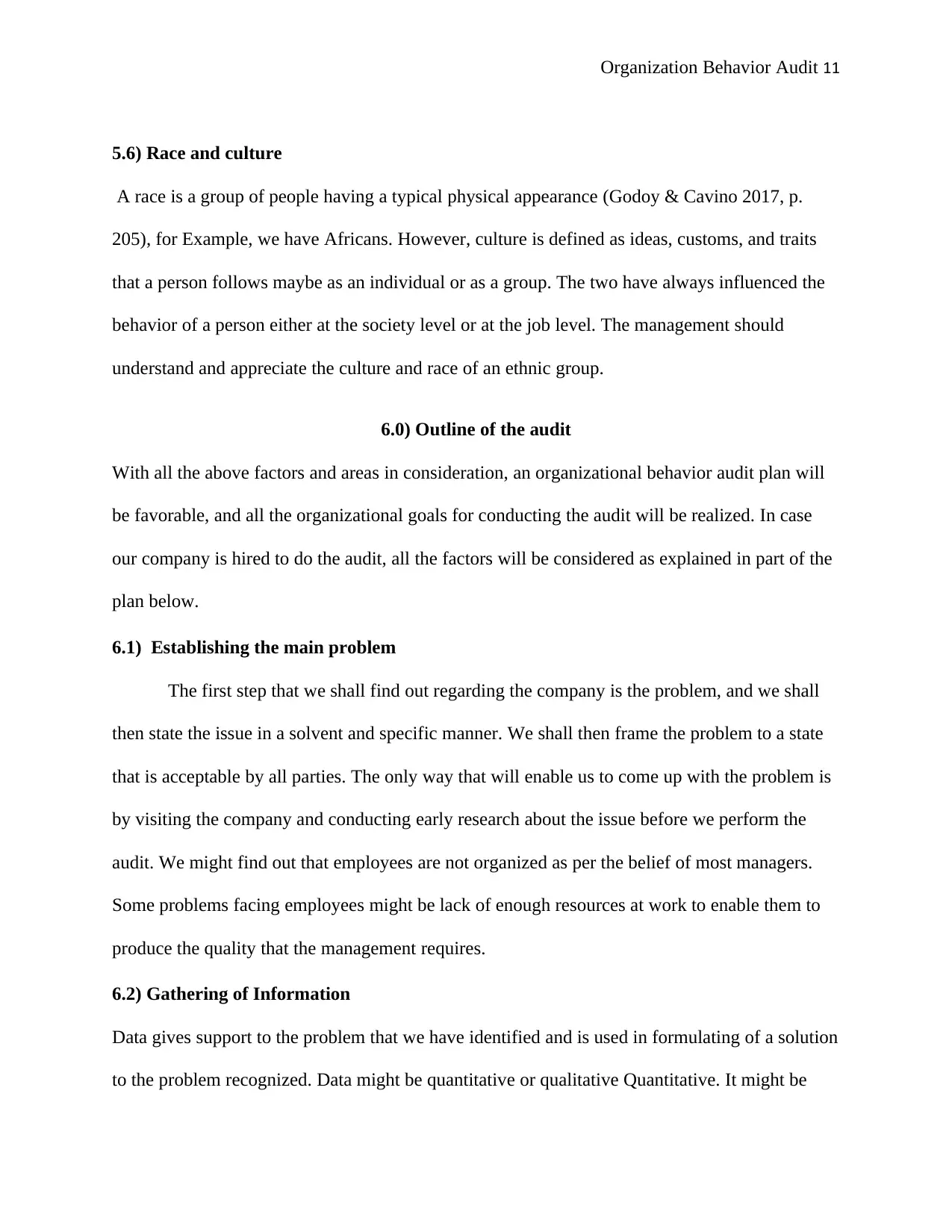
Organization Behavior Audit 11
5.6) Race and culture
A race is a group of people having a typical physical appearance (Godoy & Cavino 2017, p.
205), for Example, we have Africans. However, culture is defined as ideas, customs, and traits
that a person follows maybe as an individual or as a group. The two have always influenced the
behavior of a person either at the society level or at the job level. The management should
understand and appreciate the culture and race of an ethnic group.
6.0) Outline of the audit
With all the above factors and areas in consideration, an organizational behavior audit plan will
be favorable, and all the organizational goals for conducting the audit will be realized. In case
our company is hired to do the audit, all the factors will be considered as explained in part of the
plan below.
6.1) Establishing the main problem
The first step that we shall find out regarding the company is the problem, and we shall
then state the issue in a solvent and specific manner. We shall then frame the problem to a state
that is acceptable by all parties. The only way that will enable us to come up with the problem is
by visiting the company and conducting early research about the issue before we perform the
audit. We might find out that employees are not organized as per the belief of most managers.
Some problems facing employees might be lack of enough resources at work to enable them to
produce the quality that the management requires.
6.2) Gathering of Information
Data gives support to the problem that we have identified and is used in formulating of a solution
to the problem recognized. Data might be quantitative or qualitative Quantitative. It might be
5.6) Race and culture
A race is a group of people having a typical physical appearance (Godoy & Cavino 2017, p.
205), for Example, we have Africans. However, culture is defined as ideas, customs, and traits
that a person follows maybe as an individual or as a group. The two have always influenced the
behavior of a person either at the society level or at the job level. The management should
understand and appreciate the culture and race of an ethnic group.
6.0) Outline of the audit
With all the above factors and areas in consideration, an organizational behavior audit plan will
be favorable, and all the organizational goals for conducting the audit will be realized. In case
our company is hired to do the audit, all the factors will be considered as explained in part of the
plan below.
6.1) Establishing the main problem
The first step that we shall find out regarding the company is the problem, and we shall
then state the issue in a solvent and specific manner. We shall then frame the problem to a state
that is acceptable by all parties. The only way that will enable us to come up with the problem is
by visiting the company and conducting early research about the issue before we perform the
audit. We might find out that employees are not organized as per the belief of most managers.
Some problems facing employees might be lack of enough resources at work to enable them to
produce the quality that the management requires.
6.2) Gathering of Information
Data gives support to the problem that we have identified and is used in formulating of a solution
to the problem recognized. Data might be quantitative or qualitative Quantitative. It might be
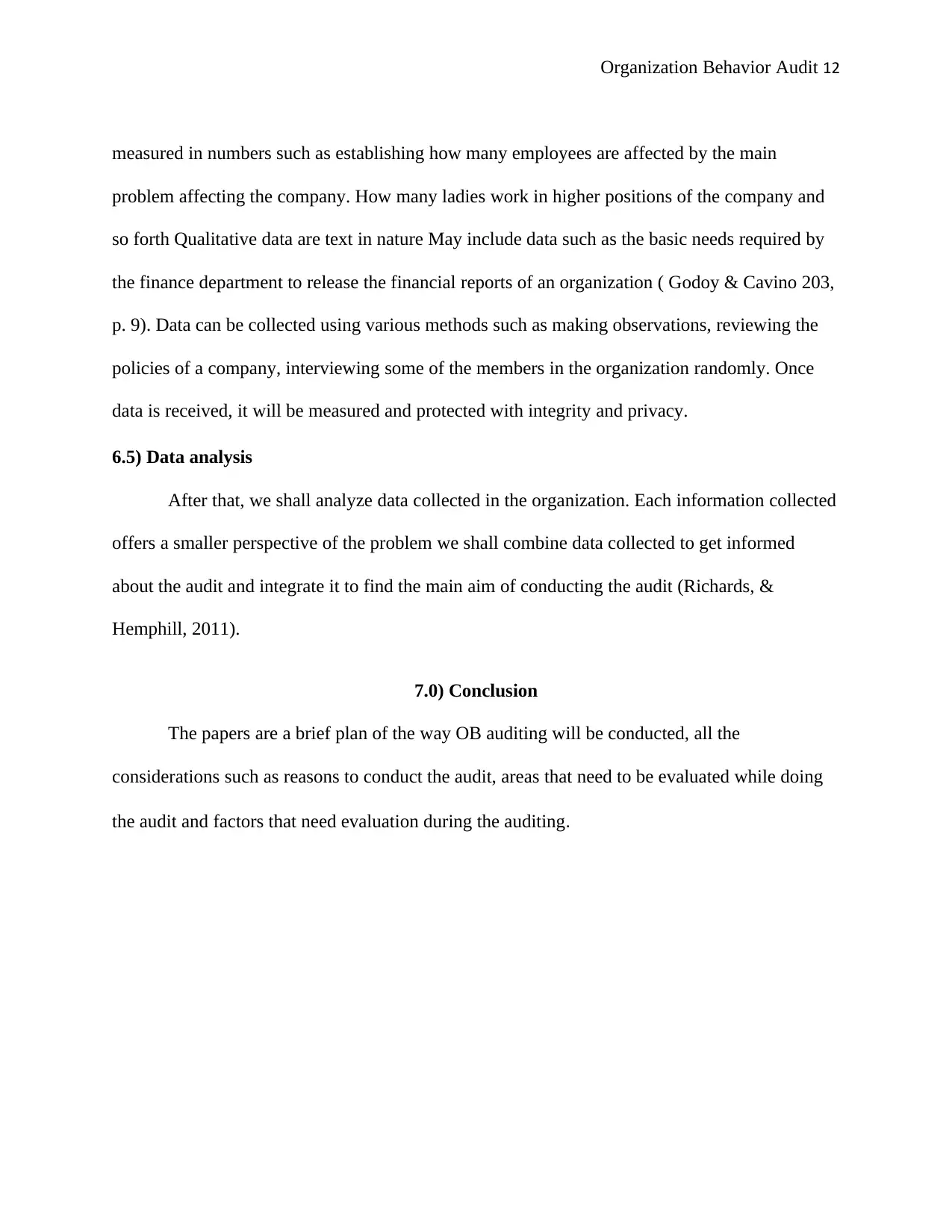
Organization Behavior Audit 12
measured in numbers such as establishing how many employees are affected by the main
problem affecting the company. How many ladies work in higher positions of the company and
so forth Qualitative data are text in nature May include data such as the basic needs required by
the finance department to release the financial reports of an organization ( Godoy & Cavino 203,
p. 9). Data can be collected using various methods such as making observations, reviewing the
policies of a company, interviewing some of the members in the organization randomly. Once
data is received, it will be measured and protected with integrity and privacy.
6.5) Data analysis
After that, we shall analyze data collected in the organization. Each information collected
offers a smaller perspective of the problem we shall combine data collected to get informed
about the audit and integrate it to find the main aim of conducting the audit (Richards, &
Hemphill, 2011).
7.0) Conclusion
The papers are a brief plan of the way OB auditing will be conducted, all the
considerations such as reasons to conduct the audit, areas that need to be evaluated while doing
the audit and factors that need evaluation during the auditing.
measured in numbers such as establishing how many employees are affected by the main
problem affecting the company. How many ladies work in higher positions of the company and
so forth Qualitative data are text in nature May include data such as the basic needs required by
the finance department to release the financial reports of an organization ( Godoy & Cavino 203,
p. 9). Data can be collected using various methods such as making observations, reviewing the
policies of a company, interviewing some of the members in the organization randomly. Once
data is received, it will be measured and protected with integrity and privacy.
6.5) Data analysis
After that, we shall analyze data collected in the organization. Each information collected
offers a smaller perspective of the problem we shall combine data collected to get informed
about the audit and integrate it to find the main aim of conducting the audit (Richards, &
Hemphill, 2011).
7.0) Conclusion
The papers are a brief plan of the way OB auditing will be conducted, all the
considerations such as reasons to conduct the audit, areas that need to be evaluated while doing
the audit and factors that need evaluation during the auditing.
⊘ This is a preview!⊘
Do you want full access?
Subscribe today to unlock all pages.

Trusted by 1+ million students worldwide
1 out of 16
Related Documents
Your All-in-One AI-Powered Toolkit for Academic Success.
+13062052269
info@desklib.com
Available 24*7 on WhatsApp / Email
![[object Object]](/_next/static/media/star-bottom.7253800d.svg)
Unlock your academic potential
Copyright © 2020–2025 A2Z Services. All Rights Reserved. Developed and managed by ZUCOL.





